
With fiscal year 2023 completed at the end of September, NRCS is leaping into fiscal year 2024. Application cut-off dates have already been announced for the Environmental Quality Incentives Program and the Agricultural Conservation Easement Program.
Thanks to the Inflation Reduction Act and other initiatives, NRCS-Michigan was able to provide farmers and forest owners over $26.7 million in conservation financial assistance through EQIP in 2023 and additional $15.3 million through the Conservation Stewardship Program. It took an amazing effort from NRCS and partner staff to make this possible. Similar funding is anticipated for fiscal year 2024 creating an amazing opportunity to get more conservation on the ground.
Taking advantage of this opportunity will require getting more farmers and forest owners into our field offices as well as a great deal of work by our staff and partners. I believe we are up to the task.
~
November is when we recognize American Indian and Alaska Heritage Month. Michigan has 12 federally-recognized American Indian Tribes and NRCS works with all of them individually on a government-to-government basis to help them protect their natural resources.
NRCS adapted our existing conservation programs to meet the needs of Michigan’s tribal communities and their agricultural traditions. This allowed NRCS to offer financial and technical assistance for conservation practices including walleye rearing ponds, wild rice planting, and aquatic organism/fish passages as well as conventional practices like seasonal high tunnels and prescribed grazing practices.
Working with American Indian Tribes has been an especially rewarding experience for NRCS and our staff and I look forward to our continuing relationship.
|
 |

Although no one in the extended Simmons family farms, or lives on the family farm, the land still brings them together. The 200-acre farm near Cedar Springs in Kent County containing crop fields, woods, a stream, and lakeshore, has been in the family since 1895.
“We’re all really tied to the land,” said Robert Simmons of his extended family’s relationship to the centennial farm.
In 2020, the family began working with NRCS and are utilizing the Regional Conservation Partnership Program (RCPP) and the Conservation Stewardship Program (CSP) to help them manage and sustain the farm. The conservation programs are allowing them to manage and improve the land for their own use as well as preserve it for future generations of the Simmons family.
Robert and his brother John grew up north of Grand Rapids and visited the farm nearly every weekend during their childhood. Today, three generations of the family regularly use the property for outdoor recreation and relaxing. Robert still lives in Kent County, John lives in Georgia but still visits the property at least annually. A cousin from Missouri was camping on the property in August next to a sand beach the family constructed on Middle Lake.
|

The family rents out the 81 acres of farmland on the property. The renter contacted the local NRCS district conservationist, Matt Soehnel, and recommended he contact the Simmons family regarding a culvert crossing on the farm. The culvert had been widened to allow farm equipment to cross over Lower White Creek by adding extensions to the existing culvert tubes. The extensions to the culvert further inhibited organism passage through the culvert and streambank erosion was a concern.
Middle Lake connects to the Rogue River by way of Lower White Creek which runs through the Simmons farm. The Rogue River is a popular fishery for trout and salmon, especially near where it joins the Grand River. Fortuitously, the Simmons farm is in the project area of the Lower Grand River Watershed Habitat Restoration and Farmland Conservation Project, funded through RCPP. The project, led by the Grand Valley Metro Council, received funding to improve water quality and fish habitat among other objectives.
|
The Simmons were able to utilize RCPP funds to replace the undersized culvert on their farm with a wider culvert that will allow fish passage from Middle Lake to Lower White Creek. USDA funding for fish passages is usually only available to American Indian tribes but funding for the practice was specifically available for the Lower Grand River Project. The family also utilized RCPP funds to create a forest management plan for the 110 acres of woods on the farm. The forest management plan was completed by a private Technical Service Provider early in 2022.
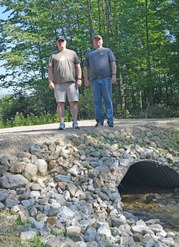
The forest management plan identified invasive species as a resource concern and the family has utilized RCPP funding to remove invasive autumn olive and multi-flora rose from their forest land. The forester also developed a selective timber harvest plan that will bring in revenue to support the farm. The forester identified 165 trees for harvest that will go out for bid to local timber buyers. The trees were selected to not negatively impact the forest habitat. Every tree marked for harvest was selected with a rationale for removing it, said Robert. The harvest is scheduled for after the 2023 deer season.
In August, the new culvert designed to allow for passage by aquatic organisms was completed. They are pleased with how the fish passage came out. “You can still hear the water flowing,” said John.
The family also enrolled the farm in CSP as part of its goal of making the farm self-supporting financially. CSP will provide annual payments over 5-years based on the conservation practices the family has implemented. The program provides additional financial assistance for further conservation enhancements on the property. They already plan to utilize CSP enhancements to improve wildlife habitat.
After the 5-year CSP contract is completed, it can be renewed for an additional 5 years, said Soehnel. “The program provides an opportunity to continue our conservation partnership with the Simmons family.”
|

The USDA Conservation Stewardship Program offers participants the flexibility to prioritize the natural resources most important to them. In the case of Charles and Cindy Jones, the natural resource most important to them has four legs and antlers.
The long-time Gladwin residents purchased a 67-acre plot of land consisting of woods and pasture about 24 years ago. The property was hardly a haven for deer or other wildlife when they purchased the land, Charles said. The trees were browsed and the hayfield was covered with snow. There were hardly any wildlife tracks or other signs of life, he said.
The couple began working with NRCS in 2008 and established switch grass on about 4 acres of land and planted a 2,000-foot windbreak, utilizing financial assistance from the Wildlife Habitat Incentive Program which was later incorporated into the Environmental Quality Incentives Program (EQIP). They planted switchgrass to create pheasant habitat however the pheasants were slow to cooperate. “The deer like it though,” said Charles. A couple of recent pheasant sightings gave him hope they may still return.
In subsequent years they utilized EQIP to develop a forest management plan emphasizing deer habitat and for forest stand improvement. They utilized the forest stand improvement practice to diversify their forest habitat by removing about three acres of white spruce and planting fruit trees and shrubs in their place. The clearing and replanting was meant to provide food for deer and other wildlife. “It’s working, we really like it,” Charles said.
With a forest management plan and other conservation practices in place, the Jones’s decided to enroll in the Conservation Stewardship Program (CSP). The program provides annual payments for maintaining their conservation practices and additional financial assistance for implementing new conservation enhancements. They enrolled in CSP in 2021 and implemented their first enhancements the following year, they included about half an acre of monarch butterfly habitat and additional tree and shrub plantings. The monarch habitat enhancement was inspired by their daughter who raises and releases the butterflies. She has released over 1,000 monarchs and now has the perfect habitat to release them in.
Charles and Cindy enjoy their property for much more than just deer hunting. Charles spends a lot of time in the hunting blinds that dot the property just to observe the wide variety of wildlife that live on their land. They also enjoy seeing the images from the trail cameras scattered around the property. From a property that was originally depleted of wildlife they now see images not only of numerous deer, but also coyotes, bobcats, fox, turkey, and hawks among many others. With a management plan and the conservation practices they’ve implemented, the winter snow went from barren when they purchased the land to looking like an “LA freeway” with all of the animal tracks, he said.
|
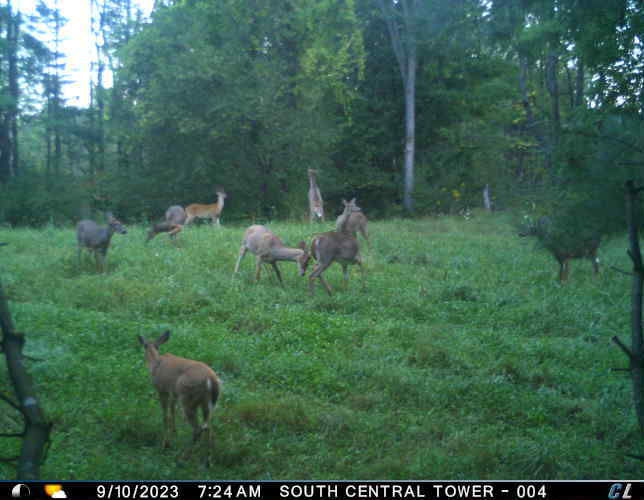 Photo taken by a trail camera on the Jones property shows deer utilzing one of the forest clearings they created.
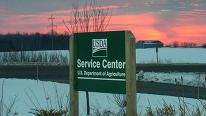
NRCS-Michigan announced an application cut-off date of Nov. 17, 2023 for the Environmental Quality Incentives Program and the Agricultural Conservation Easement Program. Completed applications received by Nov. 17, will be eligible for the current round of fiscal year 2024 funding.
NRCS accepts applications for all programs on a continuous basis. Applications received after the cut-off date will be accepted and will be eligible for future rounds of funding. Funding is also currently available through the Regional Conservation Partnership Program.
Michigan RCPP projects with available funding during fiscal year 2024 include the Tri-State Western Lake Erie Basin, Ottawa Farmland and Water Quality, and the Upper Tittabawassee River.
The Agricultural Conservation Easement Program includes both Agricultural Land Easements and Wetland Reserve Easements. Agricultural Land Easement funds are available to farmland preservation organizations, local governments, and American Indian Tribes. Wetland Reserve Easements are available to landowners who wish to restore wetlands on land that has been converted to agricultural use.
Contact your local NRCS field office for more information about USDA conservation programs.
|
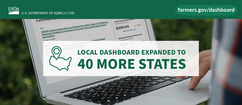
Farmers in Michigan can now access county specific farming data and USDA resources all in one place via the new farmers.gov local dashboard. Your new farmers.gov local dashboard includes farming data and USDA resources including USDA news, commodity pricing, weather forecasts, historical climate data, past storm events, USDA service center locator and additional state resources for Michigan and your county
The dashboard transforms complex data sets into easy-to-read charts and graphs to help you quickly find information that matters to you.
|
New Employees
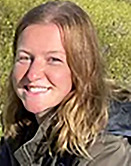
Katie Hafner - Soil Conservationist, St. Johns
Last Position: CTAI, Clinton Conservation District
Home Town: Chesaning
Education: Bachelor’s in Wildlife Biology from UM Flint
Family: husband Steven, kids, Kent, 2 & Kendall, 4 months. Pets, dog Casey
Hobbies & Interests: Family farm, gardening/homestead/habitat projects, baking, being a mom
|

Mark McLean - Soil Conservation Technician, Bay City
Last Position: Biologist & chief chemist, City of Saginaw
Hometown: Saginaw
Education: BS in biology - natural resources with a chemistry minor, Central Michigan University
Family: wife Denise, married daughter and grandson in East Jordan
Hobbies & Interests: coaching boys and girls high school soccer for 10 years. Currently, coaching the boys team at Nouvel Catholic Central in Saginaw, also enjoy traveling and going north to visit my grandson
|

Christian Stevens - Soil Conservationist, Gladwin
Last Position: Timber buyer at Maple Ridge Hardwoods and self-employed consulting forester
Hometown: Alpena
Education: B.S. Forestry and Wildlife Ecology & Management, Michigan Tech
Family: girlfriend Kady, cat Linda
Hobbies & Interests: hunting, fishing, backpacking, skiing, and snowboarding
|
Cortney VanEtten - Assistant to State Conservationist, East Lansing
Staff Updates
Brett Swanson - Area Program Specialist, Marquette (formerly soil conservationist Kingsford)
Devon Terwilliger - Soil Conservationist, Alpena (converted Pathways Intern)

November
20 - Eaton Conservation District 2023 Amateur Photo Contest submission deadline, for more information go to eatoncd.org
December
5-7 - Great Lakes Fruit, Vegetable & Farm Market Expo, 8 a.m. to 5 p.m. Monday & Tuesday, 8 a.m. to 1 p.m. Thursday, DeVos Place - Grand Rapids, for more information go to glexpo.com
13 - MAEAP Phase 1 Credit Meeting, 9 a.m. to noon, Lee Township Hall - Midland, RSVP recommended, call 989/486-2325 or email midlandconservation@macd.org, more information at midlandcd.org
13 - Thumb Ag Day, 9 a.m. to 3 p.m., 2409 E Atwater Rd. - Ubly, for more information go to www.canr.msu.edu/events
19 - Eaton Conservation District MAEAP Phase 1 Credit Meeting, 9 a.m. to 4 p.m., MSU Livestock Pavilion - Lansing and Online via Zoom, for more information and to register go to eatoncd.org
January
17-19 - Grow-Urban Agriculture Conference, 11:30 a.m. to 3:30 p.m., virtual via Zoom, for more information go to www.canr.msu.edu/events
|
|